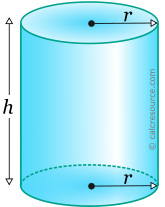Properties of Cylinder
This tool calculates the basic geometric properties of a cylinder, with a circular base. Enter the shape dimensions 'r' and 'h' below. The calculated results will have the same units as your input. Please use consistent units for any input.
r = | |||
h = | |||
Geometric properties: | |||
Volume = | |||
Surface area = | |||
Base area = | |||
Lateral surface area = | |||
 |
ADVERTISEMENT
Definitions
Geometry
The cylinder is a solid object enclosed by two parallel planar bases and a lateral cylindrical surface. Typically the most recognizable cylinder is the one with circular bases.
The volume of a circular cylinder is given by the formula:
where r the radius of the circular base and h the height of the cylinder.
The lateral surface area of the cylinder, can be found using the following formula:
Therefore the total surface area, including both bases and the lateral surface is found as:
where the base area.